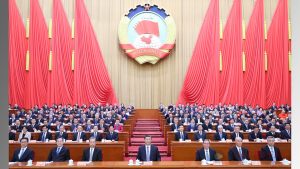China’s inbound foreign investment witnessed a 26.1% year-on-year decline in the January-March quarter, totaling 301.7 billion yuan ($41.7 billion), despite Beijing’s concerted efforts to attract global companies.
Data released by the Commerce Ministry on Friday revealed a notable deceleration in growth in March, with less than 90 billion yuan flowing in, down from 113 billion yuan in January and 102 billion yuan in February. Although the figure represents a 41% increase compared to the previous quarter, it marks the weakest first quarter since 2020 when the country grappled with the initial wave of COVID-19 infections.
Premier Li Qiang, speaking at the China Development Forum in Beijing in March, pledged to enhance the business environment and undertake reforms in crucial sectors to foster a “more open China” and foster global cooperation. This commitment followed a series of measures announced by China’s cabinet aimed at revitalizing foreign investment, including broadening market access and easing certain regulations.
Ji Xiaofeng, an official from the Commerce Ministry, attributed the decline partly to a high base in the same period last year, noting improvements in the structure of foreign investment. However, concerns persist over China’s economic recovery amid rising geopolitical tensions, with foreign direct investment into the country contracting by 8% in 2023 after years of growth during the COVID-19 era.
Last week, the Asian Development Bank cautioned that weaknesses in China’s property market and its post-pandemic recovery could dampen the region’s growth prospects. Additionally, foreign companies have been reducing their operations in China amidst government emphasis on national security, including efforts to curb espionage.
Despite the dip in foreign investment, some officials downplayed its significance. Xu Zhibin, deputy head of the foreign exchange regulator, remarked at the Boao Forum for Asia last month that China’s FDI trend aligns with the global trajectory.
Amidst the decline, there are some bright spots, with investment from Germany surging by 48% in the quarter, according to the Commerce Ministry. This increase coincided with German Chancellor Olaf Scholz’s recent visit to China, signaling potential avenues for bilateral economic cooperation.
















Comments